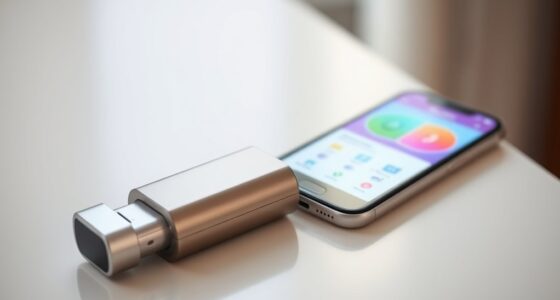Bio-printed skin grafts are revolutionizing burn treatment by using 3D printing to create personalized, functional skin layers from your own cells. This approach offers precise fitting, promotes faster healing, and reduces the risk of rejection or infection. The technology enables the production of complex, layered skin and even the inclusion of skin appendages. If you want to understand how this breakthrough is changing burn recovery, more details await as you explore further.
Key Takeaways
- Bio-printed skin grafts utilize patient-derived cells for personalized, compatible wound coverage in burn victims.
- Advanced 3D bioprinting creates layered skin structures that promote natural healing and reduce rejection risks.
- In situ bioprinting allows direct deposition of skin onto burns, speeding up recovery and minimizing surgical procedures.
- These grafts improve healing of complex and deep burns, leading to faster recovery and better functional outcomes.
- Ongoing research aims to incorporate skin features like hair follicles, enhancing regeneration for burn patients.

Have you ever wondered how advances in 3D printing are revolutionizing wound treatment? Today, bio-printed skin grafts are transforming the way burn victims recover, offering personalized solutions that match their unique needs. Unlike traditional grafts that rely on donor tissue or synthetic materials, bio-printed skin uses bio-inks made from your own cells. These bio-inks are often derived from your adipose tissue or other cell sources, creating grafts tailored specifically to your wound’s size, shape, and depth. This personalization means the grafts integrate more seamlessly with your body, reducing the risk of rejection and infection. The process involves layering your skin cells, such as keratinocytes and fibroblasts, to mimic the natural structure of your skin, including the epidermis and dermis. This layered deposition enables the graft to behave more like real skin, promoting better healing and functional recovery. Advanced biofabrication techniques allow for even more precise placement of multiple cell types and materials within the graft, enhancing its biological functionality. Additionally, ongoing innovations in cell sourcing are making the process more efficient and accessible.
Bio-printed skin grafts, made from your own cells, offer personalized, seamless wound healing solutions.
In practice, the technology allows for in situ bioprinting, where the printer deposits skin directly onto your wound, supporting faster closure and maturation of new tissue right at your bedside. Advanced techniques, like 3D laser scanning, capture the exact topography of your wound, ensuring the graft fits perfectly. Hydrogel carriers such as fibrin or collagen provide a supportive environment, keeping the cells viable and helping them integrate with your existing tissue. Portable bioprinters are also being developed, making it possible to perform these procedures directly in the hospital or even at your home, which could profoundly speed up treatment times.
The steps involved in creating a bio-printed skin graft are precise. First, clinicians define the goals—whether to replicate healthy skin or create a model for research. Then, they design a digital 3D model using CAD software, guiding the printer on the exact shape and size needed. Next, they select appropriate bio-inks that are compatible with your cells’ biochemical and physiological needs. During printing, multi-head bioprinters operate in sterile environments, often with temperature controls to keep the cells healthy. After printing, your graft is incubated in bioreactors, providing ideal growth conditions to develop a fully functional skin piece ready for transplantation.
This technology offers notable advantages over traditional methods. It can treat complex wounds more effectively, especially deep burns and chronic ulcers, reducing the number of surgeries needed. Because the grafts are customized from your own cells, rejection and infection risks decrease. Animal studies have shown promising results, with full-thickness wounds healing within three weeks. The precision of these grafts allows for better fitting, even on irregular surfaces, leading to faster healing and less scarring. As research advances, scientists continue working to improve layer integration, vascularization, and even incorporate skin appendages like hair follicles, pushing the boundaries of burn treatment and recovery.
Frequently Asked Questions
How Long Does It Take to Produce a Bio-Printed Skin Graft?
You’re wondering how long it takes to produce a bio-printed skin graft. Currently, the process takes about three weeks from start to finish. This includes scanning the wound, designing and printing the scaffold, cultivating skin cells, preparing bioinks, and allowing the graft to mature in vitro. Factors like cell cultivation, scaffold preparation, and post-printing maturation all contribute to this timeline, which can vary based on complexity and technology.
Are Bio-Printed Skin Grafts Permanent or Require Future Treatments?
You might wonder if bio-printed skin grafts last forever or need more treatments. While they promote good healing and integration, they often aren’t permanent due to challenges like material durability, cell lifespan, and healing variability. You may need future treatments to address issues like pigmentation, graft stability, or complications, especially since ongoing research aims to improve graft longevity. So, some follow-up procedures could be necessary for *best*, lasting results.
What Are the Costs Associated With Bio-Printed Skin Grafts?
You’re curious about the costs involved in bio-printed skin grafts. Right now, these costs mainly come from cell culture, bioprinting equipment, post-printing care, and labor. While the initial expenses are high due to technology and materials, potential savings come from reduced surgeries, shorter hospital stays, and fewer complications. As the technology advances and scales up, these costs could decrease, making bio-printed grafts more affordable and widely accessible.
How Do Bio-Printed Grafts Compare to Traditional Skin Grafts?
You might think traditional skin grafts are enough, but bio-printed grafts truly revolutionize healing. They eliminate the need for limited donor skin, mimic natural skin layers, and incorporate biological cues that boost integration. You get faster healing, reduced rejection, and better cosmetic results. Bio-printed grafts adapt to your body, improve functionality, and can even restore skin appendages, making them a groundbreaking leap beyond old methods.
Are There Any Risks or Rejection Issues With Bio-Printed Skin?
You should know that bio-printed skin grafts do carry some risks of rejection, especially if donor cells aren’t autologous. Immune responses can be triggered by certain cell types or materials used, leading to graft failure. Factors like insufficient vascularization, immune reactions to passenger cells, or biomaterials can also cause complications. While promising, these risks highlight the need for ongoing research to improve graft compatibility and reduce rejection chances.
Conclusion
Bio-printed skin grafts are revolutionizing burn treatment, offering new hope where there was once only despair. As you witness this breakthrough, remember it’s like planting seeds of healing that grow into living skin, restoring both appearance and confidence. This innovation isn’t just a medical advance; it’s a beacon of hope shining through the darkness. With each graft, you’re helping turn tragedy into a story of resilience and renewal, proving that science truly can heal even the deepest wounds.










